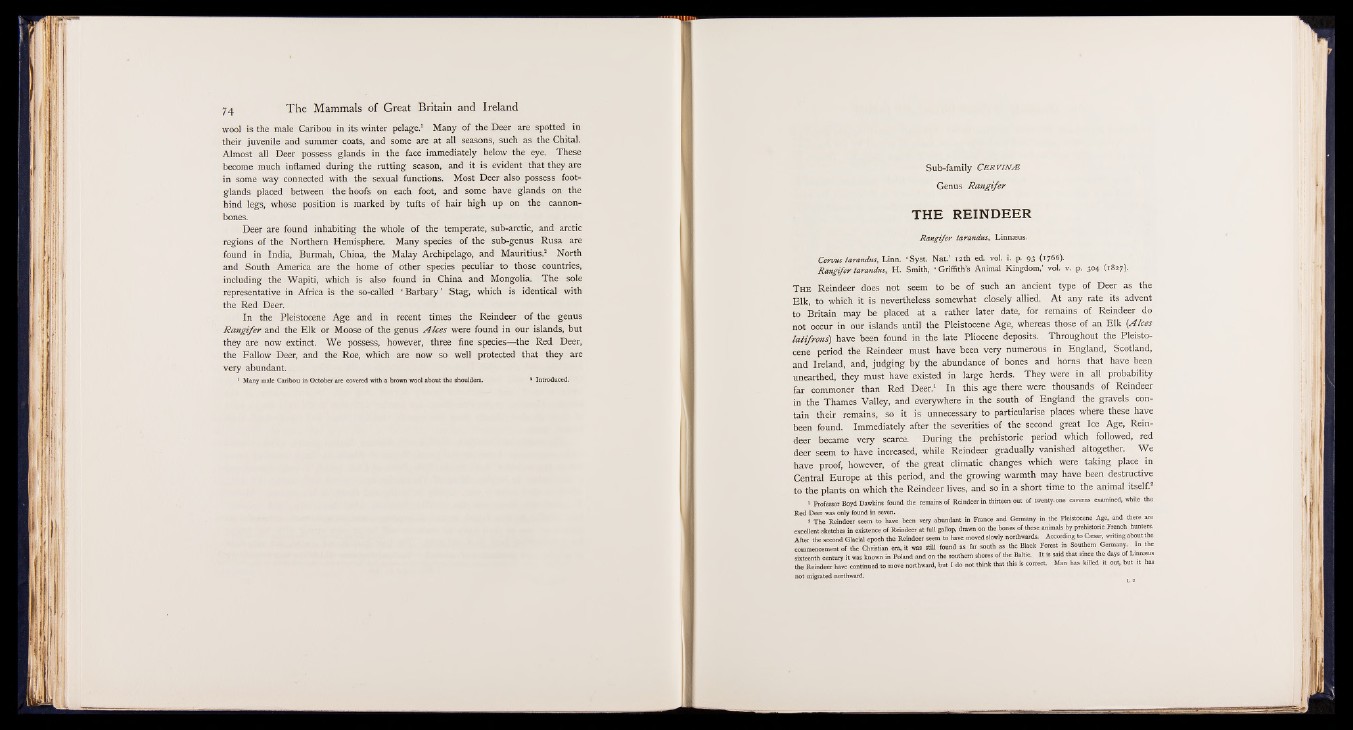
7 4
wool is the male Caribou in its winter pelage.1 Many of the Deer are spotted in
their juvenile and summer coats, and some are at all seasons, such as the Chital.
Almost all Deer possess glands in the face immediately below the eye. These
become much inflamed during the rutting season, and it is evident that they are
in some way connected with the sexual functions. Most Deer also possess foot-
glands placed between the hoofs on each foot, and some have glands on the
hind legs, whose position is marked by tufts of hair high up on the cannon-
bones.
Deer are found inhabiting the whole of the temperate, sub-arctic, and arctic
regions of the Northern Hemisphere. Many species of the sub-genus Rusa are
found in India, Burmah, China, the Malay Archipelago, and Mauritius.2 North
and South America are the home of other species peculiar to those countries,
including the Wapiti, which is also found in China and Mongolia. The sole
representative in Africa is the so-called ‘ Barbary ’ Stag, which is identical with
the Red Deer.
In the Pleistocene Age and in recent times the Reindeer of the genus
Rangifer and the Elk or Moose of the genus A Ices were found in our islands, but
they are now extinct. We possess, however, three fine species— the Red Deer,
the Fallow Deer, and the Roe, which are now so well protected that they are
very abundant.
1 Many male Caribou in October are covered with a brown wool about the shoulders. * Introduced.
Sub-family C E R VINJE
Genus Rangifer
THE REINDEER
R a n gifer tarandus, Linnseus.
Cervus tarandus, Linn. 'S y s t. N a t ’ 12th ed. vol. i. p. 93 (1766).
R a n g ifer tarandus, H. Smith, -Griffith’s Animal Kingdom,’ vol. v. p. 304 (1827)^ .
T h e Reindeer does not seem to be of such an ancient type of Deer as the
Elk, to which | § is nevertheless somewhat closely allied. At any rate its advent
to Britain may be placed at a rather later date, for remains of Reindeer do
not occur in our islands until the Pleistocene Age, whereas those of an Elk {AIces
latifrons) have been found in the late Pliocene deposits. Throughout the Pleistocene
period the Reindeer must have been very numerous in England, Scotland,
and Ireland, and, judging by the abundance of bones and horns that have been
unearthed, they must have existed in large herds. They were in all probability
far commoner than Red Deer.1 In this age there were thousands of Reindeer
in the Thames Valley, and everywhere in the south of England the gravels contain
their remains, so it is unnecessary to particularise places where these have
been found. Immediately after the severities of the second great Ice Age, Reindeer
berame very scarce. During the prehistoric period which followed, red
deer seem to have increased, while Reindeer gradually vanished altogether. We
have proof, however, of the great climatic changes which were taking place in
Central Europe at this period, and the growing warmth may have been destructive
to the plants on which the Reindeer lives, and so in a short time to the animal itself.2
1 Professor Boyd Dawkins found the remains of Reindeer in thirteen out of twenty-one caverns examined, while the
Red Deer was only found in seven.
* The Reindeer seem to have been very abundant in France and Germany in the Pleistocene Age, and there are
excellent sketches in existence of Reindeer at full gallop, drawn on the bones of these animals by prehistoric French hunters.
After the second Glacial epoch the Reindeer seem to have moved slowly northwards. According to Csesar, writing about the
commencement of the Christian era, it was still found as far south as the Black Forest in Southern Germany In the
sixteenth century it was known in Poland and on the southern shores of the Baltic. It is mid that srnce the days of Lmnrnus
the Reindeer have continued to move northward, but I do not think that this is correct. Man has killed it out, but it has
not migrated northward. ^